
Algorithms for Efficient Computation of Convolution
Convolution is an important mathematical tool in both fields of signal and image processing. It is employed in filtering, denoising, edge detection, correlation, compression, deconvolution, simulation, and in many other applications. Although the concept of convolution is not new, the efficient computation of convolution is still an open topic. As the amount of processed data is constantly increasing, there is considerable request for fast manipulation with huge data. Moreover, there is demand for fast algorithms which can exploit computational power of modern parallel architectures.
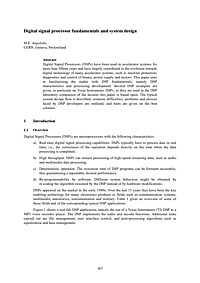
Digital Signal Processor Fundamentals and System Design
Digital Signal Processors (DSPs) have been used in accelerator systems for more than fifteen years and have largely contributed to the evolution towards digital technology of many accelerator systems, such as machine protection, diagnostics and control of beams, power supply and motors. This paper aims at familiarising the reader with DSP fundamentals, namely DSP characteristics and processing development. Several DSP examples are given, in particular on Texas Instruments DSPs, as they are used in the DSP laboratory companion of the lectures this paper is based upon. The typical system design flow is described; common difficulties, problems and choices faced by DSP developers are outlined; and hints are given on the best solution.
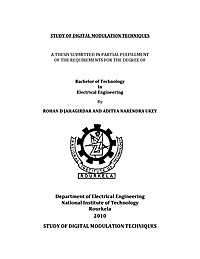
STUDY OF DIGITAL MODULATION TECHNIQUES
Modulation is the process of facilitating the transfer of information over a medium. Typically the objective of a digital communication system is to transport digital data between two or more nodes. In radio communications this is usually achieved by adjusting a physical characteristic of a sinusoidal carrier, either the frequency, phase, amplitude or a combination thereof . This is performed in real systems with a modulator at the transmitting end to impose the physical change to the carrier and a demodulator at the receiving end to detect the resultant modulation on reception. Hence, modulation can be objectively defined as the process of converting information so that it can be successfully sent through a medium. This thesis deals with the current digital modulation techniques used in industry. Also, the thesis examines the qualitative and quantitative criteria used in selection of one modulation technique over the other. All the experiments, and realted data collected were obtained using MATLAB and SIMULINK
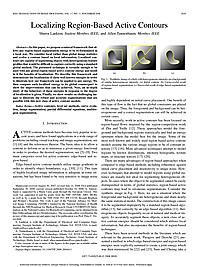
Region based Active Contour Segmentation
In this paper, we propose a natural framework that allows any region-based segmentation energy to be re-formulated in a local way. We consider local rather than global image statistics and evolve a contour based on local information. Localized contours are capable of segmenting objects with heterogeneous feature profiles that would be difficult to capture correctly using a standard global method. The presented technique is versatile enough to be used with any global region-based active contour energy and instill in it the benefits of localization. We describe this framework and demonstrate the localization of three well-known energies in order to illustrate how our framework can be applied to any energy. We then compare each localized energy to its global counterpart to show the improvements that can be achieved. Next, an in-depth study of the behaviors of these energies in response to the degree of localization is given. Finally, we show results on challenging images to illustrate the robust and accurate segmentations that are possible with this new class of active contour models.
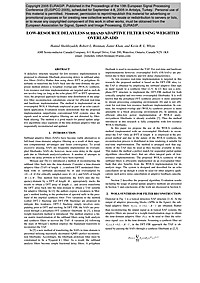
LOW-RESOURCE DELAYLESS SUBBAND ADAPTIVE FILTER USING WEIGHTED OVERLAP-ADD
A delayless structure targeted for low-resource implementation is proposed to eliminate filterbank processing delays in subband adaptive filters (SAFs). Rather than using direct IFFT or polyphase filterbanks to transform the SAFs back into the time-domain, the proposed method utilizes a weighted overlap-add (WOLA) synthesis. Low-resource real-time implementations are targeted and as such do not involve long (as long as the echo plant) FFT or IFFT operations. Also, the proposed approach facilitates time distribution of the adaptive filter reconstruction calculations crucial for efficient real-time and hardware implementation. The method is implemented on an oversampled WOLA filterbank employed as part of an echo cancellation application. Evaluation results demonstrate that the proposed implementation outperforms conventional SAF systems since the signals used in actual adaptive filtering are not distorted by filterbank aliasing. The method is a good match for partial update adaptive algorithms since segments of the time-domain adaptive filter are sequentially reconstructed and updated.
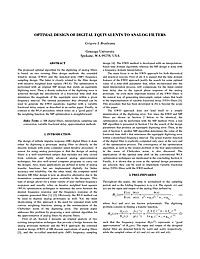
OPTIMAL DESIGN OF DIGITAL EQUIVALENTS TO ANALOG FILTERS
The proposed optimal algorithm for the digitizing of analog filters is based on two existing filter design methods: the extended window design (EWD) and the matched–pole (MP) frequency sampling design. The latter is closely related to the filter design with iterative weighted least squares (WLS). The optimization is performed with an original MP design that yields an equiripple digitizing error. Then, a drastic reduction of the digitizing error is achieved through the introduction of a fractional time shift that minimizes the magnitude of the equiripple error within a given frequency interval. The optimal parameters thus obtained can be used to generate the EWD equations, together with a variable fractional delay output, as described in an earlier paper. Finally, in contrast to the WLS procedure, which relies on a “good guess” of the weighting function, the MP optimization is straightforward.
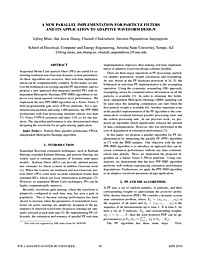
A NEW PARALLEL IMPLEMENTATION FOR PARTICLE FILTERS AND ITS APPLICATION TO ADAPTIVE WAVEFORM DESIGN
Sequential Monte Carlo particle filters (PFs) are useful for estimating nonlinear non-Gaussian dynamic system parameters. As these algorithms are recursive, their real-time implementation can be computationally complex. In this paper, we analyze the bottlenecks in existing parallel PF algorithms, and we propose a new approach that integrates parallel PFs with independent Metropolis-Hastings (PPF-IMH) algorithms to improve root mean-squared estimation error performance. We implement the new PPF-IMH algorithm on a Xilinx Virtex-5 field programmable gate array (FPGA) platform. For a onedimensional problem and using 1,000 particles, the PPF-IMH architecture with four processing elements utilizes less than 5% Virtex-5 FPGA resources and takes 5.85 μs for one iteration. The algorithm performance is also demonstrated when designing the waveform for an agile sensing application.
A pole-zero placement technique for designing second-order IIR parametric equalizer filters
A new procedure is presented for designing second-order parametric equalizer filters. In contrast to the traditional approach, in which the design is based on a bilinear transform of an analog filter, the presented procedure allows for designing the filter directly in the digital domain. A rather intuitive technique known as pole-zero placement, is treated here in a quantitative way. It is shown that by making some meaningful approximations, a set of relatively simple design equations can be obtained. Design examples of both notch and resonance filters are included to illustrate the performance of the proposed method, and to compare with state-of-the-art solutions.
Adaptive distributed noise reduction for speech enhancement in wireless acoustic sensor networks
An adaptive distributed noise reduction algorithm for speech enhancement is considered, which operates in a wireless acoustic sensor network where each node collects multiple microphone signals. In previous work, it was shown theoretically that for a stationary scenario, the algorithm provides the same signal estimators as the centralized multi-channel Wiener filter, while significantly compressing the data that is transmitted between the nodes. Here, we present simulation results of a fully adaptive implementation of the algorithm, in a non-stationary acoustic scenario with a moving speaker and two babble noise sources. The algorithm is implemented using a weighted overlap-add technique to reduce the overall input-output delay. It is demonstrated that good results can be obtained by estimating the required signal statistics with a long-term forgetting factor without downdating, even though the signal statistics change along with the iterative filter updates. It is also demonstrated that simultaneous node updating provides a significantly smoother and faster tracking performance compared to sequential node updating.
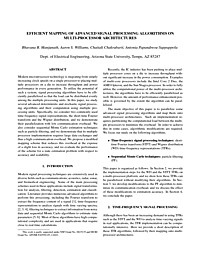
EFFICIENT MAPPING OF ADVANCED SIGNAL PROCESSING ALGORITHMS ON MULTI-PROCESSOR ARCHITECTURES
Modern microprocessor technology is migrating from simply increasing clock speeds on a single processor to placing multiple processors on a die to increase throughput and power performance in every generation. To utilize the potential of such a system, signal processing algorithms have to be efficiently parallelized so that the load can be distributed evenly among the multiple processing units. In this paper, we study several advanced deterministic and stochastic signal processing algorithms and their computation using multiple processing units. Specifically, we consider two commonly used time-frequency signal representations, the short-time Fourier transform and the Wigner distribution, and we demonstrate their parallelization with low communication overhead. We also consider sequential Monte Carlo estimation techniques such as particle filtering, and we demonstrate that its multiple processor implementation requires large data exchanges and thus a high communication overhead. We propose a modified mapping scheme that reduces this overhead at the expense of a slight loss in accuracy, and we evaluate the performance of the scheme for a state estimation problem with respect to accuracy and scalability.
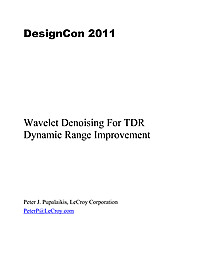
Wavelet Denoising for TDR Dynamic Range Improvement
A technique is presented for removing large amounts of noise present in time-domain-reflectometry (TDR) waveforms to increase the dynamic range of TDR waveforms and TDR based s-parameter measurements.
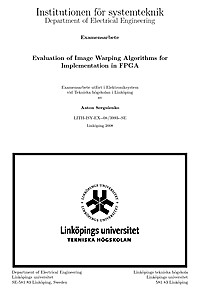
Evaluation of Image Warping Algorithms for Implementation in FPGA
The target of this master thesis is to evaluate the Image Warping technique and propose a possible design for an implementation in FPGA. The Image Warping is widely used in the image processing for image correction and rectification. A DSP is a usual choice for implantation of the image processing algorithms, but to decrease a cost of the target system it was proposed to use an FPGA for implementation. In this work a different Image Warping methods was evaluated in terms of performance, produced image quality, complexity and design size. Also, considering that it is not only Image Warping algorithm which will be implemented on the target system, it was important to estimate a possible memory bandwidth used by the proposed design. The evaluation was done by implemented a C-model of the proposed design with a finite datapath to simulate hardware implementation as close as possible.
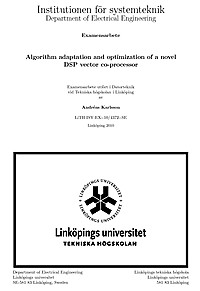
Algorithm Adaptation and Optimization of a Novel DSP Vector Co-processor
The Division of Computer Engineering at Linköping's university is currently researching the possibility to create a highly parallel DSP platform, that can keep up with the computational needs of upcoming standards for various applications, at low cost and low power consumption. The architecture is called ePUMA and it combines a general RISC DSP master processor with eight SIMD co-processors on a single chip. The master processor will act as the main processor for general tasks and execution control, while the co-processors will accelerate computing intensive and parallel DSP kernels.This thesis investigates the performance potential of the co-processors by implementing matrix algebra kernels for QR decomposition, LU decomposition, matrix determinant and matrix inverse, that run on a single co-processor. The kernels will then be evaluated to find possible problems with the co-processors' microarchitecture and suggest solutions to the problems that might exist. The evaluation shows that the performance potential is very good, but a few problems have been identified, that causes significant overhead in the kernels. Pipeline mismatches, that occurs due to different pipeline lengths for different instructions, causes pipeline hazards and the current solution to this, doesn't allow effective use of the pipeline. In some cases, the single port memories will cause bottlenecks, but the thesis suggests that the situation could be greatly improved by using buffered memory write-back. Also, the lack of register forwarding makes kernels with many data dependencies run unnecessarily slow.
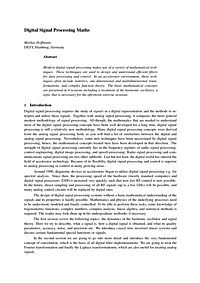
Digital Signal Processing Maths
Modern digital signal processing makes use of a variety of mathematical techniques. These techniques are used to design and understand efficient filters for data processing and control.
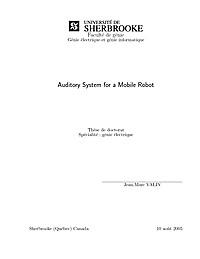
Auditory System for a Mobile Robot
The auditory system of living creatures provides useful information about the world, such as the location and interpretation of sound sources. For humans, it means to be able to focus one's attention on events, such as a phone ringing, a vehicle honking, a person taking, etc. For those who do not suffer from hearing impairments, it is hard to imagine a day without being able to hear, especially in a very dynamic and unpredictable world. Mobile robots would also benefit greatly from having auditory capabilities. In this thesis, we propose an artificial auditory system that gives a robot the ability to locate and track sounds, as well as to separate simultaneous sound sources and recognising simultaneous speech. We demonstrate that it is possible to implement these capabilities using an array of microphones, without trying to imitate the human auditory system. The sound source localisation and tracking algorithm uses a steered beamformer to locate sources, which are then tracked using a multi-source particle filter. Separation of simultaneous sound sources is achieved using a variant of the Geometric Source Separation (GSS) algorithm, combined with a multisource post-filter that further reduces noise, interference and reverberation. Speech recognition is performed on separated sources, either directly or by using Missing Feature Theory (MFT) to estimate the reliability of the speech features. The results obtained show that it is possible to track up to four simultaneous sound sources, even in noisy and reverberant environments. Real-time control of the robot following a sound source is also demonstrated. The sound source separation approach we propose is able to achieve a 13.7 dB improvement in signal-to-noise ratio compared to a single microphone when three speakers are present. In these conditions, the system demonstrates more than 80% accuracy on digit recognition, higher than most human listeners could obtain in our small case study when recognising only one of these sources. All these new capabilities will allow humans to interact more naturally with a mobile robot in real life settings.
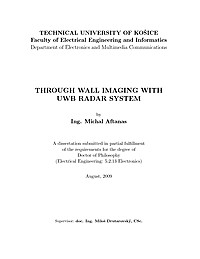
Through-Wall Imaging with UWB Radar System
Motivation: A man was interested in knowing of unknown from the very beginning of the human history. Our human eyes help us to investigate our environment by reflection of light. However, wavelengths of visible light allows transparent view through only a very small kinds of materials. On the other hand, Ultra WideBand (UWB) electromagnetic waves with frequencies of few Gigahertz are able to penetrate through almost all types of materials around us. With some sophisticated methods and a piece of luck we are able to investigate what is behind opaque walls. Rescue and security of the people is one of the most promising fields for such applications. Rescue: Imagine how useful can be information about interior of the barricaded building with terrorists and hostages inside for a policemen. The tactics of police raid can be build up on realtime information about ground plan of the room and positions of big objects inside. How useful for the firemen can be information about current interior state of the room before they get inside? Such hazardous environment, full of smoke with zero visibility, is very dangerous and each additional information can make the difference between life and death. Security: Investigating objects through plastic, rubber, dress or other nonmetallic materials could be highly useful as an additional tool to the existing x-ray scanners. Especially it could be used for scanning baggage at the airport, truckloads on borders, dangerous boxes, etc.
A Prototype Laboratory Environment for Digital Signal Processing Using Simulink and a Texas Instrument DSP Device
Normally, when a model is designed from building blocks in Simulink, the simulation is performed within the Simulink environment. A test of the design in a real-time environment requires that source code is generated, compiled and downloaded to the target hardware. As a first attempt to bridge this software gap, this thesis describes and evaluates a prototype laboratory environment, which directly links Simulink to a Texas Instrument DSP device. The prototype system converts graphical models and makes available various real-time signal processing algorithms, such as adders, delays, FFTs, IIR filters and multipliers. Future work is to consider modification of the prototype to allow for feedback in the graphical models and to find an efficient way of handling signal processing algorithms where variable buffer lengths are required.
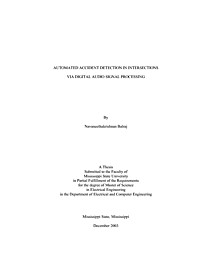
Automated Accident Detection in Intersections Via Digital Audio Signal Processing
The aim of this thesis is to design a system for automated accident detection in intersections. The input to the system is a three-second audio signal. The system can be operated in two modes: two-class and multi-class. The output of the two-class system is a label of “crash” or “non-crash”. In the multi-class system, the output is the label of “crash” or various non-crash incidents including “pile drive”, “brake”, and “normal-traffic” sounds. The system designed has three main steps in processing the input audio signal. They are: feature extraction, feature optimization and classification. Five different methods of feature extraction are investigated and compared; they are based on the discrete wavelet transform, fast Fourier transform, discrete cosine transform, real cepstrum transform and Mel frequency cepstral transform. Linear discriminant analysis (LDA) is used to optimize the features obtained in the feature extraction stage by linearly combining the features using different weights. Three types of statistical classifiers are investigated and compared: the nearest neighbor, nearest mean, and maximum likelihood methods. Data collected from Jackson, MS and Starkville, MS and the crash signals obtained from Texas Transportation Institute crash test facility are used to train and test the designed system. The results showed that the wavelet based feature extraction method with LDA and maximum likelihood classifier is the optimum design. This wavelet-based system is computationally inexpensive compared to other methods. The system produced classification accuracies of 95% to 100% when the input signal has a signal-to-noise-ratio of at least 0 decibels. These results show that the system is capable of effectively classifying “crash” or “non-crash” on a given input audio signal.
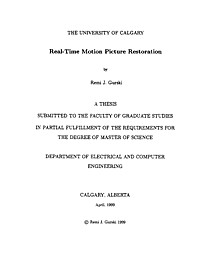
Real-time Motion Picture Restoration
Through age or misuse, motion picture films can develop damage in the form of dirt or scratches which detract from the quality of the film. Removal of these artifacts is a worthwhile process as it makes the films more visually attractive and extends the life of the material. In this thesis, various methods for detecting and concealing the effects of film damage are described. Appropriate algorithms are selected for implementation of a system, based on a TMS320C80 video processor, which can remove the effects of film defects using digital processing. The restoration process operates in real-time at video frame rates (30 frames per second). Details of the software implementation of this system are presented along with results from processing damaged film material. The effects of damage are significantly reduced after processing.

A DSP Implementation of OFDM Acoustic Modem
The success of multicarrier modulation in the form of OFDM in radio channels illuminates a path one could take towards high-rate underwater acoustic communications, and recently there are intensive investigations on underwater OFDM. In this paper, we implement the acoustic OFDM transmitter and receiver design of [4, 5] on a TMS320C6713 DSP board. We analyze the workload and identify the most time-consuming operations. Based on the workload analysis, we tune the algorithms and optimize the code to substantially reduce the synchronization time to 0.2 seconds and the processing time of one OFDM block to 1.7 seconds on a DSP processor at 225 MHz. This experimentation provides guidelines on our future work to reduce the per-block processing time to be less than the block duration of 0.23 seconds for real time operations.


















